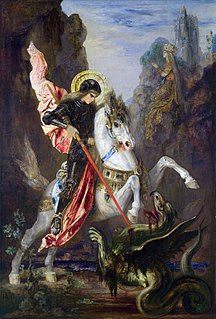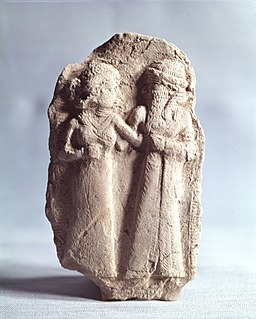Related Research Articles

Christian stories are the stories associated with Christianity. The term encompasses a broad variety of legends and stories, especially those considered sacred narratives. Mythological themes and elements occur throughout Christian literature, including recurring myths such as ascending to a mountain, the axis mundi, myths of combat, descent into the Underworld, accounts of a dying-and-rising god, flood stories, stories about the founding of a tribe or city, and myths about great heroes of the past, paradises, and self-sacrifice.

Elysium or the Elysian Fields is a conception of the afterlife that developed over time and was maintained by some Greek religious and philosophical sects and cults. It was initially separated from the Greek underworld and realm of Hades, and only mortals related to the gods and other heroes could be admitted here. Later, the conception of who could enter was expanded to include those chosen by the gods, the righteous, and the heroic. They would remain at the Elysian Fields after death, to live a blessed and happy life, and indulge in whatever employment they had enjoyed in life.

Anansi is an Akan folktale character. He often takes the shape of a spider and is sometimes considered to be a god of all knowledge of stories. Taking the role of trickster, he is also one of the most important characters of West African, African American and Caribbean folklore. Originating in West Africa, these spider tales were transmitted to the Caribbean by way of the transatlantic slave trade. Anansi is most well known for his ability to outsmart and triumph over more powerful opponents through his use of cunning, creativity and wit. Despite taking on the role of the trickster, Anansi's actions and parables often carry him as protagonist due to his ability to transform his apparent weaknesses into virtues. He is among several West African tricksters including Br'er Rabbit and Leuk Rabbit.
The term Batlôkwa refers to several Kgatla communities that reside in Botswana, Lesotho and South Africa. It comprises the followers of Tlôkwa kings and the members of clans identified as Tlôkwa, or individuals who identify themselves as of Tlôkwa descent. Most of the Batlôkwa clans trace their royal lineages to Kgwadi son of King Tabane, who was the father and founder of the Batlokwa nation. The Tlôkwa considers the Tlokwe-cat as their original totem which has since become extinct due to over-hunting for its fur, which was used by clan chiefs.

Traditional Sámi spiritual practices and beliefs are based on a type of animism, polytheism, and what anthropologists may consider shamanism. The religious traditions can vary considerably from region to region within Sápmi.

Kraal is an Afrikaans and Dutch word, also used in South African English, for an enclosure for cattle or other livestock, located within a Southern African settlement or village surrounded by a fence of thorn-bush branches, a palisade, mud wall, or other fencing, roughly circular in form. It is similar to a boma in eastern or central Africa.

Philippine mythology is the body of stories and epics originating from, and part of, the indigenous Philippine folk religions, which include various ethnic faiths distinct from one another. Philippine mythology is incorporated from various sources, having similarities with Indonesian and Malay myths, as well as Hindu, Muslim, Shinto, Buddhist, and Christian traditions, such as the notion of heaven, hell, and the human soul. Philippine mythology attempts to explain the nature of the world through the lives and actions of heroes, deities, and mythological creatures. The majority of these myths were passed on through oral tradition, and preserved through the aid of community spiritual leaders or shamans and community elders.
Comparative mythology is the comparison of myths from different cultures in an attempt to identify shared themes and characteristics. Comparative mythology has served a variety of academic purposes. For example, scholars have used the relationships between different myths to trace the development of religions and cultures, to propose common origins for myths from different cultures, and to support various psychological theories.

Vusamazulu Credo Mutwa was a Zulu sangoma from South Africa. He was known as an author of books that draw upon African mythology, traditional Zulu folklore, extraterrestrial encounters and his own personal encounters. His last work was a graphic novel called the Tree of Life Trilogy based on his writings of his most famous book, Indaba my Children. In 2018 he was honoured with an USIBA award presented by the South African Department of Arts and Culture, for his work in Indigenous Wisdom.
Hercules in the Underworld is the fourth made-for-TV movie in the series Hercules: The Legendary Journeys.

Dumuzid or Dumuzi, later known by the alternative form Tammuz, is an ancient Mesopotamian god associated with shepherds, who was also the primary consort of the goddess Inanna. In Sumerian mythology, Dumuzid's sister was Geshtinanna, the goddess of agriculture, fertility, and dream interpretation. In the Sumerian King List, Dumuzid is listed as an antediluvian king of the city of Bad-tibira and also an early king of the city of Uruk.

Greek mythology is the body of myths originally told by the ancient Greeks, and a genre of Ancient Greek folklore. These stories concern the origin and nature of the world, the lives and activities of deities, heroes, and mythological creatures, and the origins and significance of the ancient Greeks' own cult and ritual practices. Modern scholars study the myths to shed light on the religious and political institutions of ancient Greece, and to better understand the nature of myth-making itself.

Umhlanga[um̩ɬaːŋɡa], or Reed Dance ceremony, is an annual Swazi event. In Eswatini, tens of thousands of unmarried and childless Swazi girls and women travel from the various chiefdoms to the Ludzidzini Royal Village to participate in the eight-day event. The young, unmarried girls were placed in female age-regiments; girls who had fallen pregnant outside wedlock had their families fined a cow.
Myth is a folklore genre consisting of narratives that play a fundamental role in a society, such as foundational tales or origin myths. The main characters in myths are usually non-humans, such as gods, demigods, and other supernatural figures. However, others also include humans, animals, or combinations in their classificiation of myth. Stories of everyday human beings, although often of leaders of some type, are usually contained in legends, as opposed to myths. Myths are sometimes distinguished from legends in that myths deal with gods, usually have no historical basis, and are set in a world of the remote past, very different from that of the present.
The Bantu beliefs are the system of beliefs and legends of the Bantu people of Africa. Although Bantu peoples account for several hundred different ethnic groups, there is a high degree of homogeneity in Bantu cultures and customs, just as in Bantu languages. The phrase "Bantu mythology" usually refers to the common, recurring themes that are found in all or most Bantu cultures.
The Chasa Bonpuri, known in other versions as the Chesa Bonpuri or the Cheseo Bonpuri, is a Korean myth of Jeju Island. It is a myth that tells how Gangnim, the death god, came to be. As one of the best-known myths in the Korean peninsula, the Chasa Bonpuri is a characteristic hero epic.
The San religion is the traditional religion and mythology of the San people. It is poorly attested due to their interactions with Christianity.
Kwase Benefo, or Kwasi Benefo, is a mythic hero featured in the mythology of Ashanti people in Ghana. He is well known for his encounter with Amokye, the Ashanti psychopomp, during his journey to the underworld (asamando) to be reunited with his wives.
Gizo, also known as Gizzo, is a spider trickster figure present in the traditional religion of the Hausa people, who are situated in sub-Saharan Africa and are in large numbers in Nigeria, Niger, Ivory Coast, and Benin. Like many cultural depictions of spiders in African mythology, Gizo is a mythic hero.
Heitsi-eibib, also known as Haiseb or Haitse-aibeb, is a mythic hero figure in the mythology of the Khoikhoi or Khoekhoe people, who originated in southwestern Africa. He is sometimes depicted as a trickster, and with Gaunab and Tsui’goab, is a central figure in Khoekhoe folklore.
References
- 1 2 Lynch, Patricia Ann; Roberts, Jeremy (2010). African Mythology, A to Z. Infobase Publishing. ISBN 978-1-4381-3133-7.
- 1 2 Ford, Clyde W. (1999). The Hero with an African Face: Mythic Wisdom of Traditional Africa. Bantam Books. ISBN 978-0-553-10544-5.
- ↑ Scott, Miriam Van (2015-02-10). The Encyclopedia of Hell: A Comprehensive Survey of the Underworld. Macmillan. ISBN 978-1-4668-9119-7.
- 1 2 Callaway, Canon (1868). Nursery Tales, Traditions, and Histories of the Zulus, in their own words, with a Translation into English, and Notes: I. John A. Blair, Trübner.